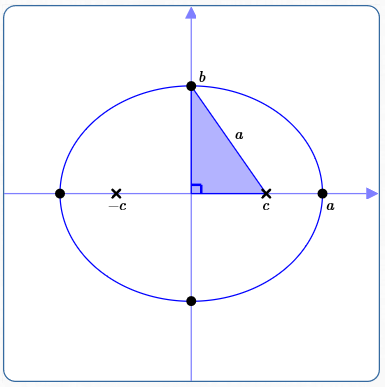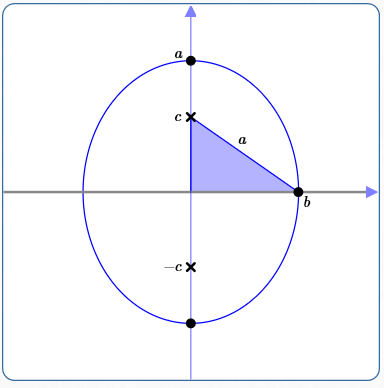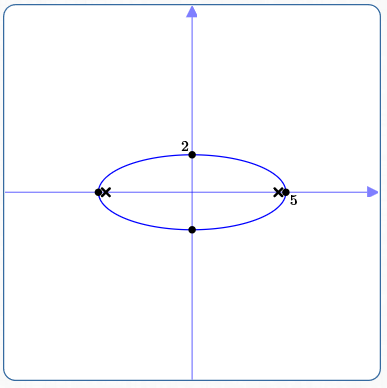 Summary: Equations of Ellipses in Standard Form
Summary: Equations of Ellipses in Standard Form
For lots more information on ellipses, see these earlier sections:
- Definition of an Ellipse
- Reflecting Property of an Ellipse
- Equations of Ellipses in Standard Form: Foci on the $x$-axis
- (optional) Getting an Ellipse by Stretching/
Shrinking a Circle - (optional) Two Useful Transforms: Reflection about the Line $\,y = x\,$ and Counterclockwise Rotation by $\,90^\circ$
- Equations of Ellipses in Standard Form: Foci on the $y$-axis
Summary: Equations of Ellipses with Centers at the Origin and Foci on the $x$-axis or $y$-axis
In Both Cases:
$\,a \gt b \gt 0$
The length of the major axis (which contains the foci) is $\,2a\,.$
The length of the minor axis is $\,2b\,.$
The foci are determined by solving the equation $\,c^2 = a^2 - b^2\,$ for $\,c\,.$
Foci on the $x$-axis

Equation of Ellipse:
$$\cssId{s12}{\frac{x^2}{\underset{\text{bigger}}{\underset{\uparrow}{a^2}}} + \frac{y^2}{b^2} = 1}$$When the foci are on the $\color{red}{x}$-axis, the bigger number ($\,a^2 \gt b^2\,$) is beneath the $\,\color{red}{x}^2\,.$
Coordinates of foci: $\,(-c,0)\,$ and $\,(c,0)\,$
Foci on the $y$-axis

Equation of Ellipse:
$$\cssId{s19}{\frac{x^2}{b^2} + \frac{y^2}{\underset{\text{bigger}}{\underset{\uparrow}{a^2}}} = 1}$$When the foci are on the $\color{red}{y}$-axis, the bigger number ($\,a^2 \gt b^2\,$) is beneath the $\,\color{red}{y}^2\,.$
Coordinates of foci: $\,(0,-c)\,$ and $\,(0,c)\,$
Tips
Recognizing an Ellipse in Standard Form
The key to recognizing the equation of an ellipse with center at the origin and foci on either the $x$-axis or $y$-axis is this:
- It has only $\,x^2\,,$ $\,y^2\,,$ and constant terms.
- When the $\,x^2\,$ and $\,y^2\,$ terms are on the same side of the equation, then they must have the same sign.
The Bigger Denominator Locates the Foci
When the bigger number is beneath the $\,x^2\,$ term, then the foci are on the $x$-axis.
When the bigger number is beneath the $\,y^2\,$ term, then the foci are on the $y$-axis.
Look for the bigger denominator to tell you where the foci lie!
Getting Intercepts
Cut down on memorization—just use standard techniques to get the $x$ and $y$ intercepts.
For example, in the equation $\,\frac{x^2}{a^2} + \frac{y^2}{b^2} = 1\,$:
Let $\,y = 0\,$ to get the $x$-intercepts $\,a\,$ and $\,-a\,$:
Let $\,x = 0\,$ to get the $y$-intercepts $\,b\,$ and $\,-b\,$:
Finding the Foci
To find the foci: $\,c^2\,$ is always the bigger denominator minus the smaller denominator.
Example: Graphing an Ellipse
Graph: $100 - 4x^2 = 25y^2$
Initial thoughts: There are only $\,x^2\,,$ $\,y^2\,$ and constant terms. When the $\,x^2\,$ and $\,y^2\,$ terms are on the same side of the equation, they have the same sign. It's an ellipse with center at the origin and foci on either the $x$-axis or $y$-axis!
Solution
$$ \begin{gather} \cssId{s48}{100 - 4x^2 = 25y^2}\cr\cr \cssId{s49}{4x^2 + 25y^2 = 100}\cr\cr \cssId{s50}{\frac{4x^2}{100} + \frac{25y^2}{100} = 1}\cr\cr \cssId{s51}{\frac{4x^2}{100}\cdot\frac{\frac 14}{\frac 14} + \frac{25y^2}{100}\cdot\frac{\frac 1{25}}{\frac 1{25}} = 1}\cr\cr \cssId{s52}{\frac{x^2}{25} + \frac{y^2}{4} = 1}\cr\cr \end{gather} $$$x$-intercepts (set $\,y = 0\,$): $\,x = \pm 5\,$
$y$-intercepts (set $\,x = 0\,$): $\,y = \pm 2\,$
Foci: The bigger number is under the $\,x^2\,,$ so the foci are on the $x$-axis.
$$ \begin{gather} \cssId{s57}{c^2 = 25 - 4 = 21}\cr\cr \cssId{s58}{c = \pm\sqrt{21}}\cr\cr \cssId{s59}{c\approx \pm 4.6} \end{gather} $$
Example: Finding the Equation of an Ellipse
Find the equation of the following ellipse:
- Center at the origin
- Major axis along the $y$-axis, with length $\,8$
- Minor axis has length $\,6$
Also, find the coordinates of the foci.
Solution
Since the major axis is along the $y$-axis, the form of the equation is:
$$ \cssId{s68}{\frac{x^2}{b^2} + \frac{y^2}{a^2} = 1} $$$a\,$ is half the length of the major axis, which is: $\,\frac{8}{2} = 4$
$b\,$ is half the length of the minor axis, which is: $\,\frac{6}{2} = 3$
The equation is:
$$ \begin{gather} \cssId{s72}{\frac{x^2}{3^2} + \frac{y^2}{4^2} = 1}\cr\cr \cssId{s73}{\frac{x^2}9 + \frac{y^2}{16} = 1} \end{gather} $$Foci: $\,c^2 = a^2 - b^2 = 16 - 9 = 7\,,$ so $\,c = \pm\sqrt{7}\,.$
Coordinates of foci: $\,(0,-\sqrt{7})\,$ and $\,(0,\sqrt{7})$